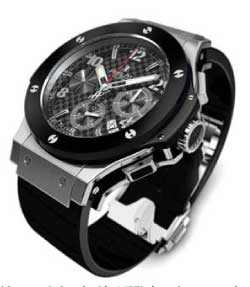With its “Big Bang” watch, the symbol of the brand’s renaissance, Hublot has been selected as a partner at the prestigious “Big Bang” exhibition at the Pompidou Centre in Paris. The exhibition takes plac from 13 June 2005 until 28 February 2006. This partnership, an encounter between the watchmaker’s art and culture, provides Hublot with a new opportunity to demonstrate the power of its fusion concept, first presented 25 years ago, and the strength of its reconstruction symbolised by the Big Bang model created in 2005.
This encounter between the watchmaker’s art and modern contemporary art was just waiting to happen. Hublot achieved this fusion by becoming the official partner of the exhibition “Big Bang”, destruction and creation in 20th century art, to take place at the Pompidou Centre in Paris from 13 June 2005 to 28 February 2006.
“It was in 1980 that Hublot first advanced the concept of “fusion” in watchmaking, by combining natural rubber from trees and gold mined from the earth,” recalls Jean-Claude Biver, CEO of Hublot. Twenty-five years on and Hublot gives birth to a unique watch, “Big Bang”, revisiting its guiding principles: the fusion of unusual materials such as gold and ceramics, Kevlar and red gold, tantalum or rubber – and a marriage between the Swiss watchmaking tradition and visionary watchmaking of the 21st century. At the same time, the Pompidou Centre is presenting an exceptional exhibition of its collections entitled Big Bang, based on an original theme: the modern Big Bang, or the link between destruction and creation in 20th century art to the present day. The Hublot brand is proud and honoured to be associated, through its Big Bang watch, with the Big Bang exhibition at the Pompidou Centre. Art, vision, destruction, deconstruction, re-enchantment, Big Bang: totally impregnated with this cultural viewpoint, promulgated by the Pompidou Centre, Hublot naturally feels elated by the proposed exhibition. Relating apparently contradictory elements, creating the necessary tension for creation, provoking movement, daring to innovate, Hublot takes up this challenge every day, developing its creations based on the power and visionary quality of its fusion concept. For this, the Big Bang model exhibited at the Pompidou Centre provides the best possible illustration.
The visionary watchmaker’s art
Just like works of art, Hublot timepieces bear the hallmarks of technology, mastery and emotion. Elevated to its highest level, the watchmaker’s craft forms an integral part of culture, art and heritage.

In their creative efforts, artists have experimented with every method of overturning established values. In the field of watchmaking, Hublot has followed the same rigorous path since 1980.
“Through this exceptional exhibition, staged entirely with works owned by the museum, the Pompidou Centre inaugurates the first entirely thematic, cross-disciplinary and transhistorical presentation of its collections, explains Catherine Grenier, the curator of the exhibition. For the first time the museum is offering visitors a completely fresh reading of the history of art.
Blending plastic arts, video, photography, architecture and design, confronting modern art with contemporary art, this concept is based on an original theme: the modern “Big Bang”, which could also be seen as destroying the old world to build a new era.”
Perfectly in step with this visionary philosophy of breaking new ground, Hublot has determined to fully support this prestigious exhibition at the Pompidou Centre. The company intends to demonstrate, through its creations, that the best of the watchmaker’s art also draws its strength from the ability to project into the future.
BIG BANG, the Watch
The first landmark in the revamping of the Hublot brand and a continuation of the fusion philosophy inaugurated in 1980, the new Big Bang chronograph reinterprets the
DNA of the brand, revisiting its original principles: the fusion of unusual materials such as gold and ceramics, Kevlar and red gold, tantalum or rubber – and the fusion of movements that combine Swiss watchmaking tradition with the visionary watchmaker’s art of the 21st century. With its angular look, built of superimposed layers of different materials, the 44.5 cm diameter casing of the Big Bang is fashioned from 18 carat gold or steel. A Kevlar insert gives the impression that the watch is traversed by the legendary Hublot natural rubber strap.
The stamped carbon dial sets off the extra-wide ceramic bezel with 6 “H”-shaped screws and Kevlar lugs. The rectangular crown and button heads have black natural rubber inserts. With a
new self-winding mechanical chronograph movement, the Hublot Big Bang will be available in the autumn of 2005.
Source : Hublot
www.hublot.com
Contact: [email protected]
(Please credit europastar.com)




